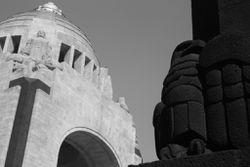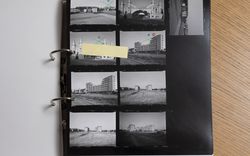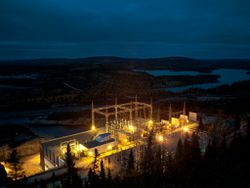Visiting scholar Adam Morton presents his research: Under capitalism, how is space organized in our everyday lives through the streets we walk, the monuments we visit, and the places where we meet? This talk presents the making of modern state space in Mexico through the perspective of a spatial political economy. It will draw on my ongoing research on the production of(...)
Shaughnessy House
22 June 2017, 6pm
Visiting Scholar Seminar: Adam Morton
Actions:
Description:
Visiting scholar Adam Morton presents his research: Under capitalism, how is space organized in our everyday lives through the streets we walk, the monuments we visit, and the places where we meet? This talk presents the making of modern state space in Mexico through the perspective of a spatial political economy. It will draw on my ongoing research on the production of(...)
Shaughnessy House
articles
Lateral Gaze
21 August 2023
Lateral Gaze
Stefano Boeri on Gabriele Basilico, in conversation with Stefano Graziani and Bas Princen
Actions:
Learning from... Chisasibi
A conversation between artist Thomas Kneubühler and filmmaker Ernest Webb, who explore housing and human migration in a small town on the eastern shore of James Bay. The conversation will be moderated by Alessandra Ponte. Taking the hydroelectric installations in Northern Quebec as his cue, Kneubühler documents how the generation of power touches the land and by extension(...)
Paul Desmarais Theatre
25 October 2012 , 7pm
Learning from... Chisasibi
Actions:
Description:
A conversation between artist Thomas Kneubühler and filmmaker Ernest Webb, who explore housing and human migration in a small town on the eastern shore of James Bay. The conversation will be moderated by Alessandra Ponte. Taking the hydroelectric installations in Northern Quebec as his cue, Kneubühler documents how the generation of power touches the land and by extension(...)
Paul Desmarais Theatre
archives
Level of archival description:
Collection
CD033
Synopsis:
The Aldo Cibic Microrealities project collection primarily consists of presentation materials, publications and born digital materials, like videos and photographs, by Aldo Cibic produced between 2003 and 2008 for the project “Microrealities”.
2003-2008
Aldo Cibic Microrealities project collection
Actions:
CD033
Synopsis:
The Aldo Cibic Microrealities project collection primarily consists of presentation materials, publications and born digital materials, like videos and photographs, by Aldo Cibic produced between 2003 and 2008 for the project “Microrealities”.
archives
Level of archival description:
collection
2003-2008
archives
Level of archival description:
Fonds
Bijoy Jain fonds
AP182
Synopsis:
The Bijoy Jain fonds documents eight projects by Bijoy Jain and the firm Studio Mumbai carried out between 2009 and 2015. Represented work includes courtyard houses in Maharashtra, Ahmedabad, and Chennai, live-work complexes in Mumbai and Dehradun, as well as two research-based projects, one for migrant housing and another an investigation of building demolition. The fonds consists of reproduced and original drawings, photographs, models, material samples, and several video recordings.
2008-2015
Bijoy Jain fonds
Actions:
AP182
Synopsis:
The Bijoy Jain fonds documents eight projects by Bijoy Jain and the firm Studio Mumbai carried out between 2009 and 2015. Represented work includes courtyard houses in Maharashtra, Ahmedabad, and Chennai, live-work complexes in Mumbai and Dehradun, as well as two research-based projects, one for migrant housing and another an investigation of building demolition. The fonds consists of reproduced and original drawings, photographs, models, material samples, and several video recordings.
archives
Level of archival description:
Fonds
2008-2015
archives
Level of archival description:
Fonds
Marcel Parizeau fonds
AP104
Synopsis:
Le Fonds Marcel Parizeau contient des documents relatifs à la formation et à la vie de professionnel de Marcel Parizeau. Il contient aussi des œuvres d'art réalisées par ce dernier. Le fonds est composé de dessins d'architecture et de meubles, de carnets de croquis, de tableaux, de manuscrits, de correspondances, ainsi que quelques autres documents.
1917-1955
Marcel Parizeau fonds
Actions:
AP104
Synopsis:
Le Fonds Marcel Parizeau contient des documents relatifs à la formation et à la vie de professionnel de Marcel Parizeau. Il contient aussi des œuvres d'art réalisées par ce dernier. Le fonds est composé de dessins d'architecture et de meubles, de carnets de croquis, de tableaux, de manuscrits, de correspondances, ainsi que quelques autres documents.
archives
Level of archival description:
Fonds
1917-1955
archives
Level of archival description:
Fonds
PGL architectes fonds
AP014
Synopsis:
Le fonds PGL architectes, 1959 – 1994, témoigne des activités de la firme d’architecture montréalaise, Papineau Gérin-Lajoie Le Blanc architectes, autant que ses sociétés affiliées et firmes remplaçantes. La majorité du fonds comprend des documents qui représentent 70 projets architecturaux, incluant des projets entrepris à travers le Québec, à Ottawa, à de multiples endroits au Nunavut, ainsi que des projets internationaux. Le fonds met en évidence la participation du PGL dans la construction d'infrastructure coloniale au Nunavik et au Nunavut, y compris les travaux sur des écoles associées avec des foyers fédéraux, qui sont reconnus comme faisant partie du système des pensionnats autochtones du Canada. De plus, le fonds documente l’utilisation des panneaux de fibre de verre modulaires employés par PGL. Pour la plupart, les documents dans ce fonds se composent des dessins, des documents photographiques, et des documents textuels. _____________________________________________________________________________________________________________ The PGL architectes fonds, 1959 - 1994, documents the work and activities of the Montréal-based architecture firm, Papineau Gérin-Lajoie Le Blanc architectes, and its successor and affiliate companies. The records within this fonds represent 70 architectural projects undertaken by the firm, which include projects throughout Québec, Ottawa, and various locations in Nunavut, as well as some international projects. The fonds offers evidence of PGL’s participation in the construction of colonial infrastructure in Nunavik and Nunavut, including work on schools that are connected to Federal Hostels which are recognised as part of Canada's Indian Residential School system. The fonds also contains records documenting PGL’s use of modular, fiberglass-reinforced plastic panels in construction. The records within this fonds largely consist of drawings, photographic materials, and textual records.
1959 - 1994
PGL architectes fonds
Actions:
AP014
Synopsis:
Le fonds PGL architectes, 1959 – 1994, témoigne des activités de la firme d’architecture montréalaise, Papineau Gérin-Lajoie Le Blanc architectes, autant que ses sociétés affiliées et firmes remplaçantes. La majorité du fonds comprend des documents qui représentent 70 projets architecturaux, incluant des projets entrepris à travers le Québec, à Ottawa, à de multiples endroits au Nunavut, ainsi que des projets internationaux. Le fonds met en évidence la participation du PGL dans la construction d'infrastructure coloniale au Nunavik et au Nunavut, y compris les travaux sur des écoles associées avec des foyers fédéraux, qui sont reconnus comme faisant partie du système des pensionnats autochtones du Canada. De plus, le fonds documente l’utilisation des panneaux de fibre de verre modulaires employés par PGL. Pour la plupart, les documents dans ce fonds se composent des dessins, des documents photographiques, et des documents textuels. _____________________________________________________________________________________________________________ The PGL architectes fonds, 1959 - 1994, documents the work and activities of the Montréal-based architecture firm, Papineau Gérin-Lajoie Le Blanc architectes, and its successor and affiliate companies. The records within this fonds represent 70 architectural projects undertaken by the firm, which include projects throughout Québec, Ottawa, and various locations in Nunavut, as well as some international projects. The fonds offers evidence of PGL’s participation in the construction of colonial infrastructure in Nunavik and Nunavut, including work on schools that are connected to Federal Hostels which are recognised as part of Canada's Indian Residential School system. The fonds also contains records documenting PGL’s use of modular, fiberglass-reinforced plastic panels in construction. The records within this fonds largely consist of drawings, photographic materials, and textual records.
archives
Level of archival description:
Fonds
1959 - 1994
Project
AP164.S1.1997.D3
Description:
The project series documents the competition entry for the presidential house, in Spain. Abalos & Herreros' design proposed that the President live as a nomad and have a house in each region of Spain. The building is shaped like a bull. The firm identified this project as number 102. According to the firm's project list the project was produced in 1997. The CCA has not yet received material for this project.
circa 1997
La Casa del Presidente, Spain (1997)
Actions:
AP164.S1.1997.D3
Description:
The project series documents the competition entry for the presidential house, in Spain. Abalos & Herreros' design proposed that the President live as a nomad and have a house in each region of Spain. The building is shaped like a bull. The firm identified this project as number 102. According to the firm's project list the project was produced in 1997. The CCA has not yet received material for this project.
Project
circa 1997
Project
Citlin
AP144.S2.D144
Description:
File documents a contribution to an exhibition hosted by the Aedes Galerie in Berlin, Germany, entitled "Berlin - Denkmal oder Denkmodell?". Price's contribution is centred around the concept of four "Annual Portals", monumental (but disassemblable and movable) structures which are apparently meant to guide the long-term flow of citizens' urban activities as they live in and eventually leave the city. Material in this file was produced in 1979 and between 1987 and 1988, but predominantly in 1988. File contains conceptual drawings, presentation panels, models, photographic materials and textual records.
1979, 1987-1988, predominant 1988
Citlin
Actions:
AP144.S2.D144
Description:
File documents a contribution to an exhibition hosted by the Aedes Galerie in Berlin, Germany, entitled "Berlin - Denkmal oder Denkmodell?". Price's contribution is centred around the concept of four "Annual Portals", monumental (but disassemblable and movable) structures which are apparently meant to guide the long-term flow of citizens' urban activities as they live in and eventually leave the city. Material in this file was produced in 1979 and between 1987 and 1988, but predominantly in 1988. File contains conceptual drawings, presentation panels, models, photographic materials and textual records.
File 144
1979, 1987-1988, predominant 1988
Project
AP207.S1.1966.PR01
Description:
This project series documents the sound performance "Tunnel Sonoro." It was created in 1966, when Pettena was experimenting with music and worked with musicians. "Tunnel Sonoro" was one of the results of his collaborations with musicians. This project consists of a sound performance during which a performer, entirely dressed in a metallic bodysuit, crosses a narrow tunnel "in which, by scrapping against the surfaces, their body 'played' the environment, imitating the sound of the wind [...]." [1] The performance was conceived for the (Musica Elettronica Viva), a live acoustic and electronic improvisational group from Rome. The project series contains a project description in Italian and in English, a reproduction of a publication from the Biennale di Firenze describing the project, and drawings of the tunnel and the metallic bodysuit. Source: [1] Marco Scotini, editor. Non-conscious architecture: Gianni Pettena, Sternberg Press, 2018, 235 pages. p. 98.
circa 1966-2018
Tunnel Sonoro [Sound Tunnel] (1966)
Actions:
AP207.S1.1966.PR01
Description:
This project series documents the sound performance "Tunnel Sonoro." It was created in 1966, when Pettena was experimenting with music and worked with musicians. "Tunnel Sonoro" was one of the results of his collaborations with musicians. This project consists of a sound performance during which a performer, entirely dressed in a metallic bodysuit, crosses a narrow tunnel "in which, by scrapping against the surfaces, their body 'played' the environment, imitating the sound of the wind [...]." [1] The performance was conceived for the (Musica Elettronica Viva), a live acoustic and electronic improvisational group from Rome. The project series contains a project description in Italian and in English, a reproduction of a publication from the Biennale di Firenze describing the project, and drawings of the tunnel and the metallic bodysuit. Source: [1] Marco Scotini, editor. Non-conscious architecture: Gianni Pettena, Sternberg Press, 2018, 235 pages. p. 98.
Project
circa 1966-2018


